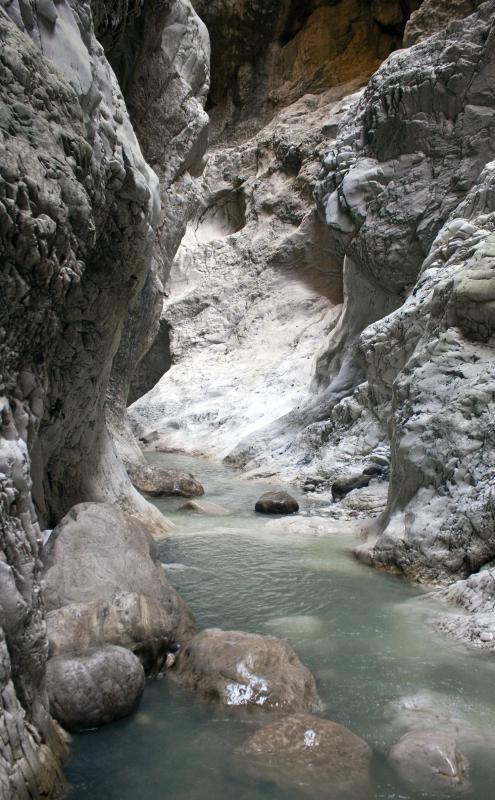At AllThingsNature, we're committed to delivering accurate, trustworthy information. Our expert-authored content is rigorously fact-checked and sourced from credible authorities. Discover how we uphold the highest standards in providing you with reliable knowledge.
What is a Grotto?
A grotto is a small cave or a structure designed to resemble a cave. In both cases, the grotto is used by people for a variety of purposes. Natural caves which are not used by humans are generally just known as “caves.” Grottoes have been a source of interest for humans for centuries, and some very interesting archaeological finds have been made in grottoes all over the world.
In the sense of a natural cave, a grotto often appears near the ocean, reflecting the processes of erosion which slowly carve out caves from the shoreline. A seashore grotto may be partially flooded during high tide, and it often has an assortment of interesting sea creatures inside. Seashore grottoes appear in some mythologies, often as homes of gods or spirits, and people have historically used them as access points for seafood, and storage locations for various goods. Kayakers and divers sometimes enjoy visiting grottoes which are only accessible by water, as these sites are often relatively unspoiled, even in heavily populated areas.

Natural grottoes can also be found inland, often near rivers, lakes, and streams. In ancient times, people undoubtedly sheltered in grottoes, but they also attached religious and cultural significance to these small caves. Some cultures decorated the walls of their local grottoes, or filled them with statues, religious offerings, and other objects related to religious faith. High-ranking members of society might even be buried in grottoes, and the conditions in some grottoes have proved to be excellent for historic preservation, allowing modern humans to see examples of ancient art and burial traditions.

In the sense of an artificial cave, people have been making grottoes since at least Roman times. The Romans used grottoes to house religious artifacts, with some more pragmatic Romans viewing their grottoes as convenient storage locations for wine and other perishable goods. Larger artificial grottoes were also used for entertaining, which explains why some restaurants are known as “grottoes.”
Artificial grottoes are also used as garden features. A grotto may be utilized to display statues and other works of art, or it may be a feature of a waterfall of arrangement of plantings. Some garden grottoes are closer to buildings than caves. When the craze for grottoes was particularly widespread in the 1800s, people made elaborate grottoes for entertaining in lavish gardens, and some of these structures still exist today in antique gardens. Garden grottoes today are especially common in religious gardens, with the grotto being used to display religious icons or to house an altar.
Frequently Asked Questions
What exactly is a grotto?
A grotto is a natural or artificial cave that is often associated with historic, religious, or cultural significance. Natural grottos are formed by geological processes such as the erosion of rock, often by water. Artificial grottos are man-made and can be found in gardens, parks, and within architectural structures, serving as tranquil retreats or places of contemplation.
How are natural grottos formed?
Natural grottos are typically formed through the erosion of soluble rocks such as limestone, dolomite, and gypsum. Water plays a significant role, as it can dissolve these rocks over time, creating cavities and caverns. The process can take thousands of years, with factors like the acidity of the water and the presence of natural faults influencing the formation.
Can grottos have ecological significance?
Yes, grottos can have substantial ecological significance. They often provide unique habitats for a variety of wildlife, including bats, insects, and specific species of flora that thrive in the damp, sheltered environment. Some grottos also house rare or endemic species, making them important sites for conservation and biological study.
Are grottos used for religious purposes?
Grottos have been used for religious purposes throughout history. Many are considered sacred sites and are destinations for pilgrimage, prayer, and reflection. The most famous example is the Grotto of Massabielle in Lourdes, France, where the Virgin Mary is said to have appeared to Saint Bernadette. Such sites often attract millions of visitors annually seeking spiritual solace.
What is the difference between a grotto and a cave?
The main difference between a grotto and a cave is size and openness. A grotto is typically smaller than a cave and is often partly open to the sky, which allows light to enter, creating a unique atmosphere. Caves, on the other hand, are larger, deeper, and usually entirely enclosed, with extensive networks of chambers and tunnels.
Are there famous grottos one can visit?
There are many famous grottos around the world that attract tourists and pilgrims. The Blue Grotto in Capri, Italy, is renowned for its dazzling blue waters, while the Reed Flute Cave in China is famous for its stunning stalactite and stalagmite formations. The aforementioned Grotto of Massabielle in Lourdes is also a well-known religious site.
AS FEATURED ON:
AS FEATURED ON:












Discussion Comments
a grotto is also a group of cavers in the NSS.
Post your comments